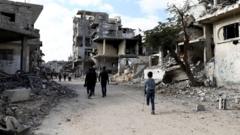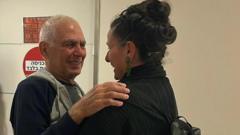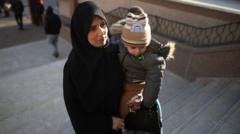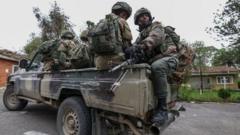As hostilities subside in Gaza after a lengthy conflict, the onset of a recovery phase reveals a tragic landscape. Rescue workers estimate thousands may still be buried under rubble, and the UN has reported dire conditions for the population, who rely heavily on incoming aid. Though a ceasefire has sparked hope, families face the daunting task of rebuilding lives amidst profound loss.
Gaza Begins Healing Amidst Ruins and Loss

Gaza Begins Healing Amidst Ruins and Loss
Following a ceasefire, the toll of destruction in Gaza prompts a massive rescue and recovery effort amidst dire humanitarian needs.
In the aftermath of a ceasefire, Gaza’s residents and rescue teams are confronting an immense tragedy as they assess the widespread destruction across the region. The Civil Defense agency in Gaza is bracing for the chilling revelation that over 10,000 bodies could still lie buried beneath the rubble left by months of conflict. With expressed hopes of recovering the deceased within 100 days, they face severe equipment shortages, hampering their efforts amid ongoing despair.
Recent images emerging from Gaza highlight the relentless devastation resulting from a 15-month Israeli military offensive, particularly in the northern regions of the enclave. While celebratory sounds replaced the roar of bombs as the ceasefire commenced this past Sunday, the stark reality remains; many lives have been irrevocably altered. The World Food Programme (WFP) has reported that more than 2 million Gazans are now homeless, reliant entirely on food aid for survival.
On the same day the ceasefire took effect, cargo trucks laden with essential supplies began streaming into Gaza, with the UN indicating at least 630 lorries crossed the border—marking the most significant influx since military actions began. Sam Rose, acting director of UNRWA in Gaza, underscored the extensive rebuilding required, emphasizing that assistance must extend beyond mere food supplies to encompass healthcare, infrastructure, and psychological support for traumatized communities.
The gravity of the situation was further reflected in a press conference held by families of recently released hostages in Israel, which underscored the human cost of the conflict. Heartfelt accounts from families determined to support those still affected by the crisis came amidst more challenging revelations: over 46,900 fatalities and extensive infrastructural damage in Gaza, with many calling for urgent humanitarian intervention.
As the Israeli military begins to withdraw from populated areas, safety remains a continued concern for those seeking to return to their homes. Residents experience a mixture of anticipation and fear as they navigate the debris of their past lives. While some, like 42-year-old Hatem Eliwah, cling to hope for a return home, the reality casts a long shadow of grief for many who have lost family members and belongings.
In a transformative moment at the UN Security Council, Secretary-General Antonio Guterres termed the ceasefire a "ray of hope," urging all parties to uphold their commitments due to the precarious situation in the West Bank. He cautioned against potential escalations, stressing significant legal implications regarding any plans to annex parts of the area.
As Gaza begins the arduous path to recovery, the echoes of loss remain a constant reminder of the work still ahead. The interplay of hope and despair continues as communities strive to rebuild amidst harrowing cries for aid emerging from the rubble.
Recent images emerging from Gaza highlight the relentless devastation resulting from a 15-month Israeli military offensive, particularly in the northern regions of the enclave. While celebratory sounds replaced the roar of bombs as the ceasefire commenced this past Sunday, the stark reality remains; many lives have been irrevocably altered. The World Food Programme (WFP) has reported that more than 2 million Gazans are now homeless, reliant entirely on food aid for survival.
On the same day the ceasefire took effect, cargo trucks laden with essential supplies began streaming into Gaza, with the UN indicating at least 630 lorries crossed the border—marking the most significant influx since military actions began. Sam Rose, acting director of UNRWA in Gaza, underscored the extensive rebuilding required, emphasizing that assistance must extend beyond mere food supplies to encompass healthcare, infrastructure, and psychological support for traumatized communities.
The gravity of the situation was further reflected in a press conference held by families of recently released hostages in Israel, which underscored the human cost of the conflict. Heartfelt accounts from families determined to support those still affected by the crisis came amidst more challenging revelations: over 46,900 fatalities and extensive infrastructural damage in Gaza, with many calling for urgent humanitarian intervention.
As the Israeli military begins to withdraw from populated areas, safety remains a continued concern for those seeking to return to their homes. Residents experience a mixture of anticipation and fear as they navigate the debris of their past lives. While some, like 42-year-old Hatem Eliwah, cling to hope for a return home, the reality casts a long shadow of grief for many who have lost family members and belongings.
In a transformative moment at the UN Security Council, Secretary-General Antonio Guterres termed the ceasefire a "ray of hope," urging all parties to uphold their commitments due to the precarious situation in the West Bank. He cautioned against potential escalations, stressing significant legal implications regarding any plans to annex parts of the area.
As Gaza begins the arduous path to recovery, the echoes of loss remain a constant reminder of the work still ahead. The interplay of hope and despair continues as communities strive to rebuild amidst harrowing cries for aid emerging from the rubble.






















